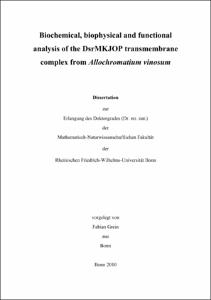Grein, Fabian: Biochemical, biophysical and functional analysis of the DsrMKJOP transmembrane complex from Allochromatium vinosum. - Bonn, 2010. - Dissertation, Rheinische Friedrich-Wilhelms-Universität Bonn.
Online-Ausgabe in bonndoc: https://nbn-resolving.org/urn:nbn:de:hbz:5N-23730
Online-Ausgabe in bonndoc: https://nbn-resolving.org/urn:nbn:de:hbz:5N-23730
@phdthesis{handle:20.500.11811/4698,
urn: https://nbn-resolving.org/urn:nbn:de:hbz:5N-23730,
author = {{Fabian Grein}},
title = {Biochemical, biophysical and functional analysis of the DsrMKJOP transmembrane complex from Allochromatium vinosum},
school = {Rheinische Friedrich-Wilhelms-Universität Bonn},
year = 2010,
month = dec,
note = {In the present study the DsrMKJOP transmembrane complex was investigated and characterized by biochemical, biophysical and functional analyses. Each of the proteins was successfully produced in E. coli as recombinant proteins and purified. The complex was furthermore enriched from A. vinosum and analysed. It has been shown that DsrJ is a triheme cytochrome c and EPR spectroscopy provided evidence for a possible, but only partial, His/Cys heme ligation in one of the hemes. This heme shows heterogeneous coordination with methionine being another candidate ligand. Cysteine 46 was replaced by serine using site-directed mutagenesis, with the mutant protein showing a significant decrease in the EPR signal attributed to His/Cys coordination, but identical UV-Vis and resonance Raman spectra. The redox potentials of the hemes in the wild type protein were determined to be -20,-200 and -220 mV and were found to be virtually identical in the mutant protein. However, in vivo the same ligand exchange led to a dramatically altered phenotype highlighting the importance of Cys46. The results suggest that Cys46 may be involved in catalytic sulfur chemistry rather than electron transfer. It was furthermore shown that the signal peptide of DsrJ is not cleaved off in A. vinosum and that it may anchor the protein into the membrane. DsrM was identified as a diheme cytochrome b and the two hemes were found to be in low spin state. Their midpoint redox potentials were determined to be +60 and +110 mV. Although no hemes were predicted for DsrP, it was also clearly identified as a b-type cytochrome. As obvious from the literature, this is the first time that heme binding has been experimentally proven for a member of the NrfD protein family. Both cytochromes were partly reduced after addition of a menaquinol analogue suggesting interaction with quinones in vivo. DsrO and DsrK were both experimentally proven to be Fe-S-containing proteins. In addition, DsrK was shown to be membrane-associated most likely via an in-plane membrane anchor. Coelution assays provide support for the proposed interaction of DsrK with the soluble cytoplasmic protein DsrC, which might be its substrate. The results obtained in this study were combined in a model for the function of the DsrMKJOP complex in A. vinosum.},
url = {https://hdl.handle.net/20.500.11811/4698}
}
urn: https://nbn-resolving.org/urn:nbn:de:hbz:5N-23730,
author = {{Fabian Grein}},
title = {Biochemical, biophysical and functional analysis of the DsrMKJOP transmembrane complex from Allochromatium vinosum},
school = {Rheinische Friedrich-Wilhelms-Universität Bonn},
year = 2010,
month = dec,
note = {In the present study the DsrMKJOP transmembrane complex was investigated and characterized by biochemical, biophysical and functional analyses. Each of the proteins was successfully produced in E. coli as recombinant proteins and purified. The complex was furthermore enriched from A. vinosum and analysed. It has been shown that DsrJ is a triheme cytochrome c and EPR spectroscopy provided evidence for a possible, but only partial, His/Cys heme ligation in one of the hemes. This heme shows heterogeneous coordination with methionine being another candidate ligand. Cysteine 46 was replaced by serine using site-directed mutagenesis, with the mutant protein showing a significant decrease in the EPR signal attributed to His/Cys coordination, but identical UV-Vis and resonance Raman spectra. The redox potentials of the hemes in the wild type protein were determined to be -20,-200 and -220 mV and were found to be virtually identical in the mutant protein. However, in vivo the same ligand exchange led to a dramatically altered phenotype highlighting the importance of Cys46. The results suggest that Cys46 may be involved in catalytic sulfur chemistry rather than electron transfer. It was furthermore shown that the signal peptide of DsrJ is not cleaved off in A. vinosum and that it may anchor the protein into the membrane. DsrM was identified as a diheme cytochrome b and the two hemes were found to be in low spin state. Their midpoint redox potentials were determined to be +60 and +110 mV. Although no hemes were predicted for DsrP, it was also clearly identified as a b-type cytochrome. As obvious from the literature, this is the first time that heme binding has been experimentally proven for a member of the NrfD protein family. Both cytochromes were partly reduced after addition of a menaquinol analogue suggesting interaction with quinones in vivo. DsrO and DsrK were both experimentally proven to be Fe-S-containing proteins. In addition, DsrK was shown to be membrane-associated most likely via an in-plane membrane anchor. Coelution assays provide support for the proposed interaction of DsrK with the soluble cytoplasmic protein DsrC, which might be its substrate. The results obtained in this study were combined in a model for the function of the DsrMKJOP complex in A. vinosum.},
url = {https://hdl.handle.net/20.500.11811/4698}
}






